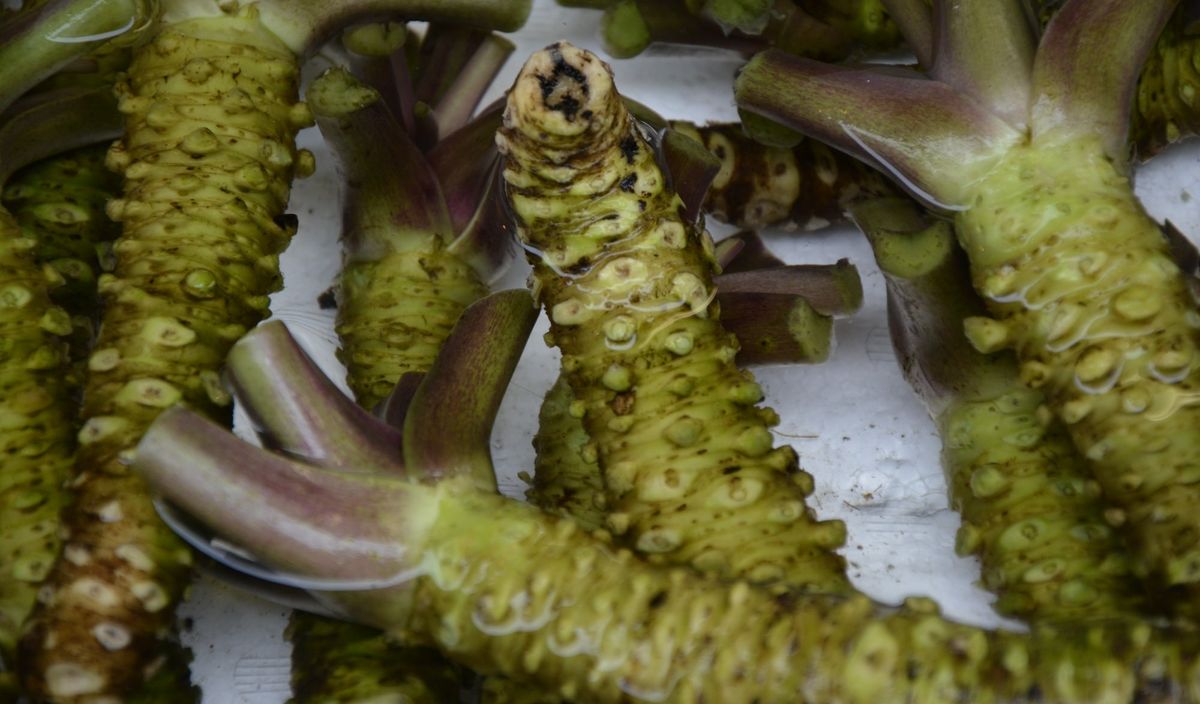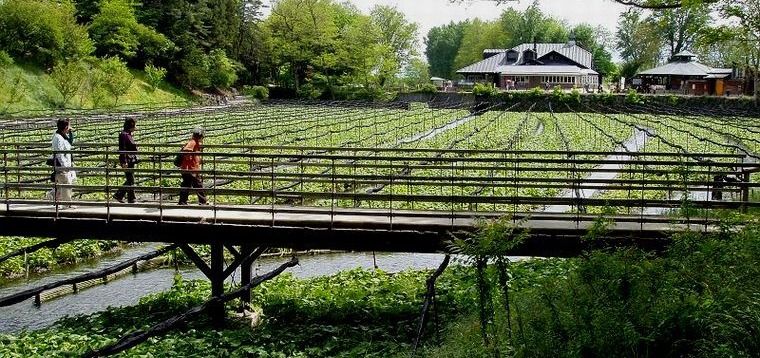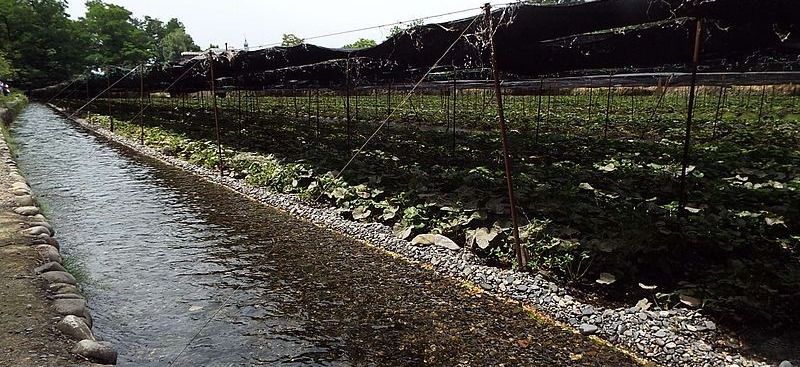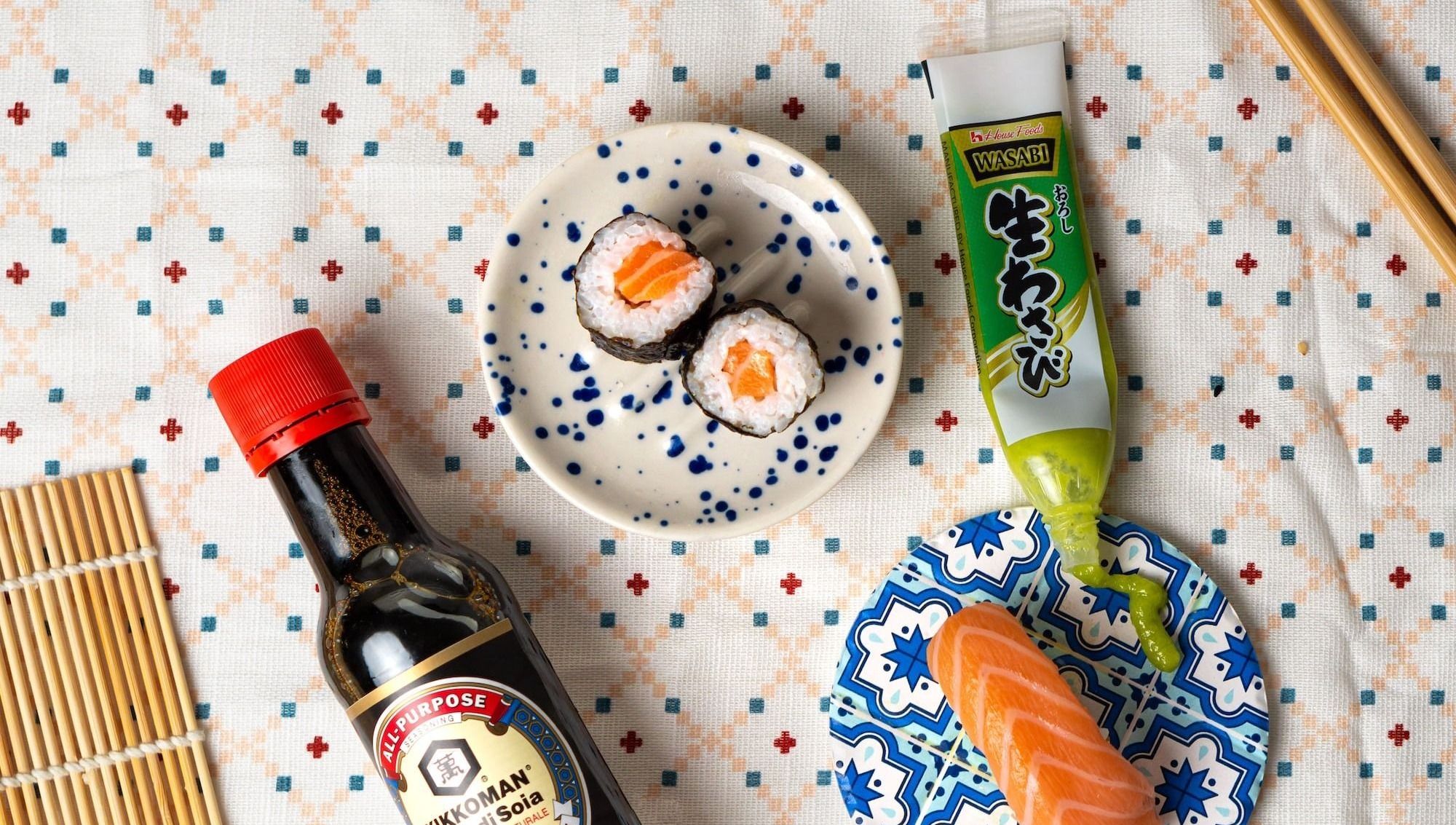Why Is The Real Wasabi So Expensive?
Unveiling the Truth of the Real Wasabi and Why Is It So Expensive

What Is Wasabi?
Wasabi (山葵), scientifically known as Wasabia japonica, is a plant indigenous to Japan. This plant's rhizome, which is the underground stem, is harvested and used as a zesty condiment, much appreciated in Japanese cuisine.
Often associated with dishes like sushi, sashimi in omakase style, it can be mixed with soy sauce for a fiery dipping sauce or sprinkled as a spice on various dishes. Additionally, wasabi flavor is popular in numerous processed food items.
Variants of Wasabi
Interestingly, horseradish, another condiment from the same family, is termed "seiyo-wasabi" (Western wasabi) to differentiate it from the traditional Japanese "hon-wasabi."
Historically, wild wasabi flourished in mountain streams. However, cultivation began around 400 years ago. There are two main types:
1) Sawa-wasabi: Grown near water sources like springs, it's mostly consumed by grating the roots. They are superior in quality, offering a more potent flavour and extremely expensive.
2) Hata-wasabi: Cultivated in the cooler mountainous regions, both its leaves and stems are edible. Beyond the renowned root, wasabi's leaves and stems offer a distinct, sharp taste. They're commonly used in processed items like Japanese pickles.
Popular Varieties of Wasabi
Wasabi is cultivated in several distinctive varieties, each prized for its unique flavor profile and characteristics:
- Mazuma (True Wife): Celebrated for its perfect balance of sweetness and pungency, Mazuma is regarded as the ideal choice for sushi. Its cultivation demands exceptional care, making it a rare and highly coveted variety.
- Daruma: Recognizable by its dark leaves and plump roots, Daruma was once a popular choice. However, its popularity has waned due to the challenges associated with its cultivation.
- Masamidori: As a descendant of Mazuma, this variety boasts enhanced resistance to diseases and higher yield potential, making it a preferred option among modern cultivators.
- Shimane-sangou: Known for its resilience in sunny, warm climates, this variety offers a delightful balance of spiciness and sweetness, catering to diverse culinary preferences.
What’s The Price of Real Wasabi?
Authentic wasabi carries a hefty price tag; the cost differs by region. In the United States or Europe, it can be quite expensive, reaching up to $396 per kilogram.
Meanwhile, in Japan, the prices are relatively more moderate, ranging between $125 to $252 per kilogram, varying based on its availability.
The Top Wasabi Producer in Japan
Shizuoka and Nagano are the leading prefectures in Japan for sawa-wasabi cultivation, together contributing to over 90% of its national production. Their plentiful spring water sources and temperate weather conditions make them ideal for sawa-wasabi farming.
On the other hand, when it comes to hata-wasabi production, Iwate Prefecture takes the lead, providing about 60% of the entire country's output.
Did You Know
Surprisingly, over 90% of the wasabi paste offered in restaurants and stores, whether in Japan or internationally, isn't genuine wasabi. Most often, the "wasabi" you're enjoying is merely green-dyed horseradish.
What Is The Flavor Profile of Wasabi?
Genuine wasabi presents a pungent kick that primarily targets the nasal passages. As you savor it more deeply, it reveals a subtle herbal undertone accompanied by a hint of natural sweetness, all without leaving a burning aftertaste. This nuanced flavor profile contrasts with the horseradish-based wasabi paste, which tends to be harsher.
For those unfamiliar with Japanese cuisine, encountering wasabi might be an entirely novel experience. However, when paired with the right dishes like sushi or sashimi, many come to appreciate its unique taste.
Why Is Wasabi So Expensive?

1. Strict Cultivation Requirements
Environment: Wasabi requires very specific conditions to grow. It thrives in cool climates and prefers a consistent temperature between 8°C and 20°C (46°F to 68°F), which means best to grow on the peaks of Japanese mountains, typically between elevations of 750 to 900 meters.

Light: Wasabi is sensitive to direct sunlight and prefers cooler temperatures. Naturally, it thrives in areas that are well-shaded, receiving only about 30% direct sunlight.
Clean, Nutrient-rich Water: The plant needs a constant flow of clean, fresh water. That's why it's often found the cultivation process uses terraced fields, where water cascades from the top tiers down to the lower ones, leveraging the plentiful spring water available in mountain river valleys in Japan.
Soil: Wasabi thrives in well-draining soil that's rich in organic matter, ideally with a pH level between 6 and 7. It's essential to ensure the plant's roots are fully submerged in the soil, which should extend up to where the lowest stems begin. Too much humidity or any slight change in these conditions can affect the plant's health.
2. Lengthy Growth Period
Wasabi takes a long time to mature. A wasabi plant requires 24 to 36 months to grow before its rhizomes are large enough to harvest. It can achieve a height of roughly 2 feet, comparable to the knee level, and has a similar lateral spread.
3. Delicate and Susceptible to Pests
The plant is susceptible to various diseases and pests, making it a challenging crop to cultivate consistently.
The leaves and stems (petioles) of wasabi are rather delicate. Any harm from wildlife, manual labor, or mishandling can hinder its growth, occasionally causing it to pause momentarily.
4. Labor-Intensive
Wasabi farming is labor-intensive. The plants need constant attention and care. Maintaining wasabi plants involves diligent weeding and monitoring for issues like mildew, fungi, and insect infestations.
It's crucial to ensure water inlets remain unclogged from surrounding tree debris and that each plant receives consistent water flow. During rainy periods, channels are constructed to drain excess water and manage water circulation.
It's more than just watering: netting is deployed to deter wild animals, like deer, which are fond of wasabi leaves. The entire cultivation process demands significant effort, making individual attention to each plant a time-consuming task.
Harvesting is also done by hand, further adding to the cost.
5. Limited Growing Regions in Japan
Wasabi cultivation on a large scale is challenging and only feasible in specific regions. In Japan, the primary areas for wasabi cultivation include:
The Izu Peninsula in Shizuoka Prefecture, recognized both globally and nationally in Japan as an "Agricultural Heritage System for Traditional Wasabi Farming."
Nagano Prefecture, which houses the Daio Wasabi Farm in Azumino, both a significant tourist draws and the largest commercial wasabi farm globally.
Iwate Prefecture and Shimane Prefecture, renowned for its Hikimi wasabi variety.
6. High Demand vs. Limited Supply
The demand for real wasabi is high, especially in Japanese cuisine, but the supply is limited due to the challenges of cultivation. This disparity further drives up the price.
The proliferation of sushi bars and eateries in the US in recent times has led to a heightened demand for authentic Wasabi to elevate the dining experience.
Consequently, fresh Wasabi's price has soared above $300 per kg, a result of limited supply in the West and its sparse commercial cultivation outside Asia.
A couple of challenges to Wasabi production include its two-year growth cycle and the potential loss due to diseases during this period.
7. Short Shelf Life
Once the wasabi rhizome is harvested, it has a very short shelf life. The natural shelf life of raw wasabi root is limited in comparison to its processed counterparts.
When refrigerated with its rhizome uncut, it can endure for roughly two weeks. If it deteriorates, its texture becomes soft and mushy.
8. Imitations

Because of its high price and limited availability, many products labeled as "wasabi" are primarily composed of European horseradish, frequently tinted with green food dye.
In many cases, the actual wasabi content is minimal, making up just about 1-3% of the entire composition. This widespread use of substitutes makes genuine wasabi even more sought after and valuable.
Given these challenges and the meticulous care required to produce genuine wasabi, it's understandable why it commands such a high price in the market.
How To Prepare Wasabi?
To enjoy authentic wasabi, the rhizome is typically grated. While modern methods employ metal or porcelain graters, traditional practices favored the use of sharkskin for this purpose. The resulting texture is akin to finely grated ginger, although wasabi has a smoother consistency.
After grating, it's ideal to let the wasabi sit briefly for a minute or two, allowing its distinct aroma and pungent flavor to emerge. Yet, this intensity is fleeting.
In about 20 minutes, the genuine, pungent flavor of fresh wasabi starts to dissipate. This is the reason why many traditional Japanese sushi establishments only grate wasabi upon customer requests, ensuring its freshness and potency.
What Are The Features of Wasabi?
Spiciness: Unlike chili peppers which produce a burning sensation on the tongue, wasabi produces a sharp, pungent sensation that hits the nasal passages.
Color: Pure wasabi has a pale green hue. It is worth noting that many commercial "wasabi" products are actually made from horseradish, mustard, and green food coloring, giving them a more vibrant green appearance.
Texture: Real wasabi, when freshly grated, has a gritty, almost pasty texture.
Taste: Beyond its spiciness, genuine wasabi has a complex flavor profile. It offers an initial aromatic sensation followed by a subtle sweetness before its signature spiciness.
Aroma: Its scent is somewhat herbal and plant-like, with a refreshing note.
Short-lived heat: The heat from wasabi dissipates fairly quickly compared to the lingering burn one might experience with chilies.
Shelf-life: The pungent flavor of fresh wasabi begins to diminish within about 15 minutes of grating. This is why traditional Japanese restaurants might grate it fresh for dishes.
Appearance: The Wasabia japonica plant has large, tropical-looking leaves and stems which also have a spicy flavor.
Understanding these features can help consumers distinguish authentic wasabi from the more common horseradish-based substitutes found in many restaurants and stores.
What Is The Best Tool To Grate Wasabi?
For wasabi enthusiasts, traditional sharkskin graters stand out as the utensil of choice. While these graters embody craftsmanship and tradition, owning one isn't essential for savoring wasabi's unique flavor.
There are two perspectives on this. On one side, genuine wasabi is already an expensive indulgence. So, spending up to $150 on a traditional grater might seem excessive, especially when one might argue that an inexpensive plastic version could suffice.
Conversely, if you're investing in real wasabi, why not go the extra mile for an authentic experience? Settling for the commonly served imitation wasabi mix — which combines horseradish, mustard, and a hint of real wasabi — is akin to cutting corners.
For those conscious about their budget, smaller artisanal graters are available at a more affordable price.
Owning a genuine grater not only elevates the wasabi experience but also brings authenticity that even dedicated Western aficionados of Japanese cuisine may miss. Experts such as Jon Old, a pioneer in European wasabi cultivation, and renowned French sushi chef Manu Letellier lean towards Japanese metal graters. Though these produce finely grated wasabi, traditionally they were avoided to prevent any metallic aftertaste. This attention to detail underscores the care involved in wasabi preparation, highlighting why sharkskin graters have been considered the gold standard.
What Is Wasabi's Health Benefits?
Wasabi boasts a range of health benefits, largely attributed to a compound known as 6-Methylsulfinylhexyl isothiocyanate (6-MSITC) that's released when its roots are grated.
Research indicates that 6-MSITC serves several functions: it acts as an antioxidant, aids detoxification, enhances blood circulation, and potentially helps in cancer prevention. Furthermore, its properties benefit skin health, making it a component in some beauty products.
However, it's important to note that consuming authentic wasabi is crucial for these benefits, as many commercial wasabi pastes are adulterated with ingredients like hon-wasabi and horseradish, diminishing its efficacy.
The distinct spicy kick of wasabi comes from another compound, allyl isothiocyanate (AITC). This compound showcases potent antibacterial and anti-mold properties.
Hence, it's found in various products designed to combat bacteria and mold. The intensity of wasabi's pungency is heightened the finer it is grated, as this breaks down more cellular tissue, releasing increased amounts of AITC.
What Is Wasabi Other Purpose?
Historically, wasabi served a practical purpose: it masked fish odors and was known to halt bacterial growth, preventing food spoilage. Its association with sushi began in the latter part of the Edo period (1603-1867), when it started being added to hand-rolled sushi.
With sushi's global popularity, wasabi's prominence has soared. It's no longer exclusive to Japanese dishes; it's found its way into steaks, occasionally replacing horseradish with roast beef, and as a secret touch in various sauces and dressings.
Thanks to its distinctive sharpness and refreshing flavor, wasabi continues to intrigue chefs and food enthusiasts, finding its place in diverse culinary traditions beyond just Japanese cuisine.
How Is Wasabi Used In Japanese Cuisine?
Sushi: Typically accompanied by wasabi, sushi occasionally incorporates it within the rice. The spicy punch of wasabi complements raw fish and elevates dense rolls.
Sashimi: This raw fish delicacy usually comes with a dab of wasabi. It accentuates the fish's flavor and counterbalances its rich consistency.
Ramen: For those seeking a zesty twist, wasabi can be stirred into ramen broth. It particularly harmonizes with pork-rich broths and fiery toppings.
Soba: These buckwheat noodles often come with a wasabi paste side. Blending the wasabi into the chilled dipping sauce introduces an added layer of flavor to the dish.
How Can You Tell The Difference Between Real Wasabi Vs. Fake Wasabi?
To discern between authentic and imitation wasabi, start by examining its texture. Genuine wasabi, when freshly grated, has a coarse, gritty feel. In contrast, a creamy and pasty consistency often suggests a horseradish-based substitute.
In upscale sushi establishments, chefs prioritize freshness. They precisely grate just the right amount of wasabi to complement the sushi's flavor and enhance the fish's taste. This freshly grated wasabi is typically tucked between the sushi's topping and rice, ensuring it remains fresh. If you notice a chef periodically grating a green substance, it's likely authentic wasabi.
Authentic wasabi boasts a multifaceted taste, beginning with a sharp spiciness that mellows into a sweet, refreshing afterglow. This contrasts with imitation wasabi, which delivers a bold and prolonged burn, lacking the subtlety of the real deal.
In terms of appearance, genuine wasabi presents a muted green hue, while its counterfeit often sports a vibrant green, thanks to additives like artificial dyes or spinach juice. Imitation wasabi, with its extended shelf life, is typically offered in paste or powder form, ready to be combined with water.
Why Is Wasabi Oftenly Paired With Sushi?
Wasabi is traditionally paired with sushi for several reasons:
1. Flavor Enhancement: Wasabi adds a pungent kick that complements the subtle flavors of fish and rice, elevating the overall taste experience.
2. Antimicrobial Properties: Historically, wasabi was used because of its natural antimicrobial qualities. It could help reduce the risk of foodborne illnesses, especially with raw fish dishes.
3. Texture Contrast: The gritty texture of freshly grated wasabi provides a nice contrast to the soft and smooth texture of sushi.
4. Culinary Tradition: The pairing of wasabi with sushi has deep roots in Japanese culinary practices. Over time, this combination has become a staple, setting a standard for sushi consumption worldwide.
5. Sensory Experience: The sharp sensation that wasabi provides stimulates the nasal passages, offering a unique sensory experience that differs from the usual tongue-based spiciness.
Incorporating wasabi into sushi serves both practical and sensory purposes, enhancing the overall dining experience.


